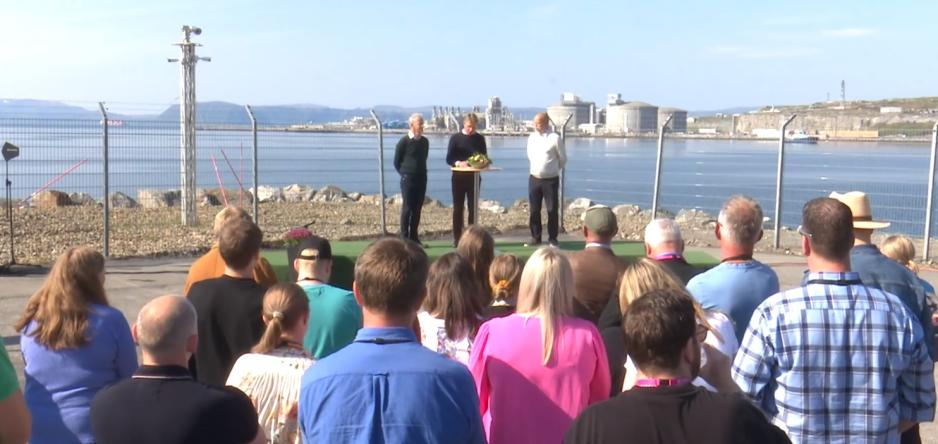Norwegian Government Approves Electrification of Melkøya LNG Plant in Northern Norway

From the press conference with Prime Minister Jonas Gahr Støre, Minister of Finance Trygve Slagsvold Vedum and Minister of Petroleum and Energy Terje Aasland in Hammerfest. The Government presented a major boost in power and industry in Finnmark, Northern Norway. (Photo: Screenshot).
The Norwegian government favors electrifying Equinor's LNG plant on Melkøya outside Hammerfest. At the same time, a plan for significant expansion of power generation and grids in Norway's northernmost region is being launched.
On Tuesday, Prime Minister Jonas Gahr Støre (Labor), Minister of Finance Trygve Slagsvold Vedum (Center), and Minister of Petroleum and Energy Terje Aasland (Labor) presented the news that the government is in favor of the electrification of the LNG plant on Melkøya outside Hammerfest.
"This will trigger the largest single climate measure ever adopted by a Norwegian government. It will enable a cut of 850,000 tonnes of Co2 per year," says Støre at the press conference.
The Prime Minister also highlights the geopolitical situation Europe now finds itself in, which has made energy security even more critical. The Snøhvit field accounts for approximately five percent of Norwegian gas exports, and Hammerfest LNG is Norway's only facility for liquefied natural gas.
"This is also important outside our own country - for our allies," he says.
Power and industry boost
The LNG plant on Melkøya outside Hammerfest in northern Norway receives and processes natural gas from the Snøhvit field in the Barents Sea. Until now, the gas power plant has supplied the production at the facility. In the event of electrification, the power plant will be shut down, and the plant will be operated with electricity from the transmission grid.
Many are concerned that electrification will require so much grid capacity in Finnmark that there will not be enough left for other industrial projects in the region.
In connection with the electrification of Melkøya, the government is also launching a plan specifically for significant expansion of power production and networks in Finnmark.
"This is a major power and industry boost for the northernmost part of our country where we as a nation are completely dependent on a strong civilian presence," says Støre and continues:
"There is a strong security policy dimension to the decision we are now making. In the north, there is a requirement to get started with new grid development and new renewable power. We shall come out of this strengthened, and it shall not be a project where we end up with winners and losers."
The government highlights two important goals:
- That new infrastructure for electricity in Finnmark must be in operation by 2030, provided a concession.
- At the same time, renewable power production in Finnmark must increase at least as much as the planned increase in consumption at Hammerfest LNG by 2030, provided concession.
The energy situation in Finnmark
- Electrification of the gas plant will require enormous amounts of electricity. At the same time, the power situation in Finnmark, particularly in the eastern part, is already under pressure.
- There are plans for a 420kV power line from Western Finnmark to Eastern Finnmark, which will improve the power grid in the region. One of the sections on the line, from Lebesby to Varangerbotn, will precisely improve network capacity in Eastern Finnmark.
- Statnett has also applied for concession for a 420kV line from Skaidi to Hammerfest. This decision is based on Equinor's plans for the electrification of its plant on Melkøya and the electricity demand this triggers, according to Statnett.
Postponing provides more time
In order to have time to strengthen the power system in Finnmark before Hammerfest LNG needs increased power output, the government states that they are setting the following conditions: Hammerfest LNG can only change the power supply from gas turbines to complete operation with power from the grid from 1 January 2030, unless the Ministry decides otherwise.
The plan for conversion to complete operation with power from the grid was initially set for 2028. The postponement gives more time to strengthen the power system in the region, writes the government.
Security policy dimension
"A prerequisite for further growth in Finnmark is more power, which enables us to create new industries and more jobs. This package will help to further develop the largest industrial plant in Finnmark while at the same time facilitating new establishments. Getting more power and better power supply in this area is also an important part of overall preparedness and our national security," says Minister of Finance Trygve Slagsvold Vedum.
"A secure power supply is fundamental to societal security. This is a condition for society to function in such a way that other national security interests are safeguarded. The Armed Forces' abilities also depend on secure and predictable power from civilian energy supplies. A robust power supply is thus important for Norway's overall defense capability," adds Minister of Defense Bjørn Arild Gram (Centre Party).
Snøhvit Future
Hammerfest LNG is Northern Norway's largest industrial plant and currently employs 500 people.
The Snøhvit Future project entails measures that both increase gas production from the Snøhvit field and extend the lifetime of Hammerfest LNG.
Source: Regjeringen.no
Also read
This article was originally published in Norwegian and has been translated by Birgitte Annie Molid Martinussen.


